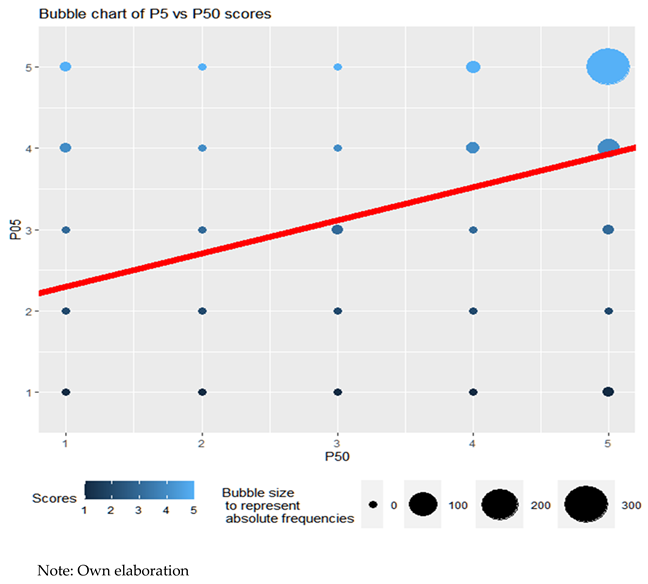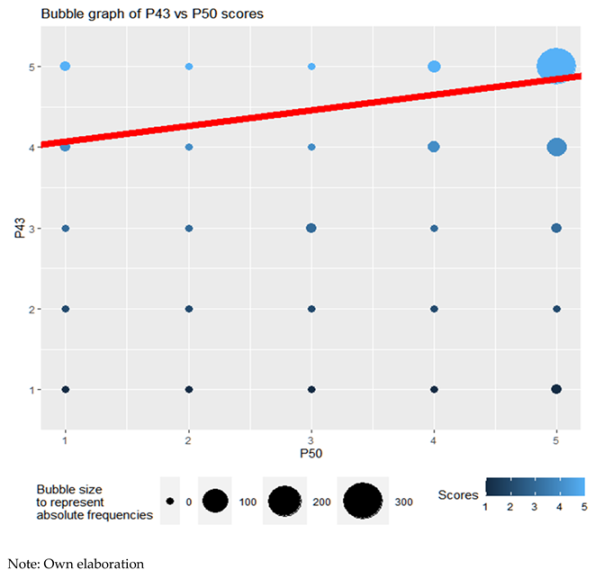EJIHPE | Free Full-Text | Emotional Competences of Primary Education Teachers: A Need in School Post COVID-19
[ad_1]
Analysis of Compliance with the Hypotheses Raised
The personal characteristics and emotional competences of teachers interfere in the management of students, finding differences depending on sociodemographic and professional variables (sex, age, professional experience, type of center in which they work, whether they have children and teaching vocation).
- (a)
-
Ability to interpret emotions
It should be noted that the proportion of teachers who score high (4 or 5) is CI95% = (93.9, 98.0), that is, the vast majority believes they are able to interpret and observe the emotions and feelings of students. These high scores do not depend on sex (Fisher, p-value = 0.3309), the type of center (Fisher, p-value = 0.5726), experience (Fisher, p-value = 0.1368) or age (Fisher, p-value = 0.3380).
- (b)
-
Respect for students
On the other hand, the emotional competencies of teachers also have a lot to do with the way in which teachers interact with students, how they treat them and how they see them. In that sense, it is necessary to analyze the relationship of personal, educational and cultural respects.
Men score higher than women (Wilcoxon, p-value = 0.01283 < 0.05), that is, they reject prejudice, racism and discrimination more. Of the teachers who answer 1, that is, who disagree with the statement of rejecting prejudice, racism and discrimination, 88% are women and 12% men. This reality has a difficult explanation.
The proportion of men who score high (4 or 5) is higher, with a p-value = 0.02053 < 0.05, although, with such a tight p-value, the result is inconclusive.
The contrast of proportions gives a p-value = 0.7532 > 0.05. Consequently, the proportion of teachers who score high (4 or 5) is the same in subsidized and public schools.
The contrast of proportions of those who score 4 or 5 to contrast if the proportion among those who have children is higher gives a p-value = 0.03624 < 0.05. Therefore, it is higher among those who have children, although with an inconclusive result (very tight p-value).
The p-value = 0.3390 for the independence contrast (Fisher) indicates that the proportion of those who score 4 or 5 is similar according to teaching experience.
The independence contrast (Fisher) for the variables age and high scores (4 or 5) gives us a p-value = 0.02939. So, there is dependence between both variables. It seems that teachers over the age of 40 tend to give higher scores.
Correspondence analysis shows that a score of 5 is associated with the highest age (over 41 years).
- (c)
-
Teaching vocation–self-esteem
In this section, it is observed how teachers who like their work tend to promote the self-esteem of their students. This denotes a concern for the emotional development of their students. Although the existence of this linear relationship is observed (ANOVA for linear regression, p-value = 0.006 < 0.05), this is not very intense: R2 = 0.018. For nonparametric correlations, the results are similar. The Kendall rank correlation coefficient (Kendall’s coefficient τ) of value τ = 0.175 is significant with a p-value = 0.001 < 0.05. Spearman’s rank correlation coefficient (Spearman’s ρ) of value ρ = 0.177 is significant (p-value = 0.001 < 0.05). The bubble graph of the scores, as well as the line adjusted to the point cloud using least squares, attest to this.
Classroom management presents significant differences with respect to the emotional competences of teachers depending on professional and sociodemographic variables (sex, age, professional experience, type of center in which they work, whether they have children and teaching vocation).
- (a)
-
Conflict management
The way of managing conflicts by teachers has a high emotional charge within the educational process. Analyzing the preparation of teachers to resolve such conflicts in an appropriate way—taking into account the emotional aspects—falls within their professional competence.
These percentages of teachers who feel unprepared do not depend on sex (contrast of proportions, p-value = 0.9753), nor on whether they have children (contrast of proportions, p-value = 0.5505), on the type of center (contrast of proportions, p-value = 0.7839), on experience (contrast of proportions, p-value = 0.4920) or age (contrast of proportions, p-value = 0.9227).
- (b)
-
Methodological aspects
Creating learning environments for listening to students improves academic performance and the quality of interpersonal relationships. Both pedagogical initiatives have a high emotional depth and generate motivation and a desire to learn.
- (a)
-
For this case, the one-way ANOVA p-value (age), not assuming equal variances (Welch test), gives us a p-value = 0.0251 < 0.05. Therefore, there are significant differences between the groups.
- (b)
-
Post hoc contrasts indicate that the highest average score is obtained by the 20–30 age group and that the 41–50 age group obtains the minimum average score, with the difference between the two groups being significant.
- (c)
-
The differences between the rest of the age groups are not significant.
- (a)
-
The Kruskal–Wallis test with a p-value = 0.002005 < 0.05 rejects the null hypothesis that the populations from which the samples have been extracted are equidistributed.
- (b)
-
Post hoc contrasts using Wilcoxon to compare each pair of age groups and adjusting the p-value using the Holm method give a similar result.
From the table, it can be deduced that the only significant difference occurs between age groups 20–30 vs. 41–50.
The Fisher test to contrast the equality of proportions between both groups gives a p-value = 0.9999 > 0.05. Therefore, it cannot be denied that the proportion of teachers who score high (4 or 5) is the same between both sexes. The confidence interval for those who score high, regardless of sex, is as follows: CI95%= (96.9, 99.4).
- (c)
-
Vocation–conflict management
The results show how teachers who like their work tend, slightly, to prepare more to manage conflicts well, although this relationship is not very marked, since the correlation coefficients τ of Kendall (τ = 0.018) and ρ of Spearman (ρ = 0.112) are only slightly positive. Moreover, with such tight p-values, the decision on their significance is inconclusive. The bubble graph of the scores, as well as the line adjusted to the point cloud using least squares, prove it.

[ad_2]


